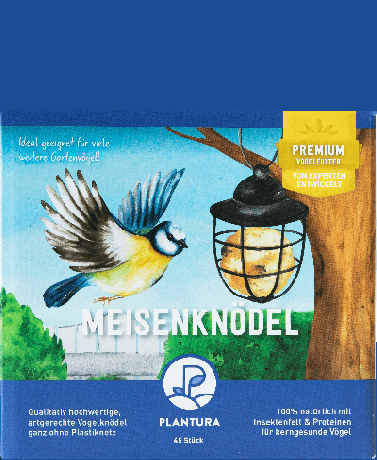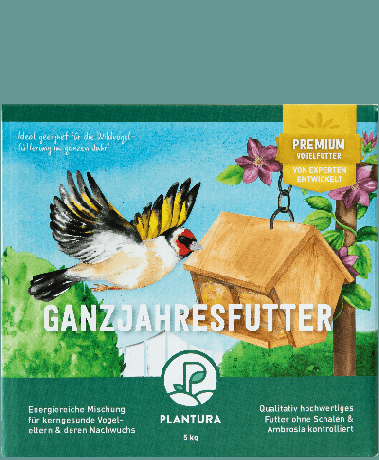Besides bird seed, there are many other ways you can help birds survive in your garden or on your balcony. In the following you will learn how to turn your garden into a true paradise for the feathered garden dwellers.

Home gardens are an important habitat for a variety of bird species. In our increasingly monotonous and intensified landscape, wild birds find less and less food and habitat and are therefore increasingly fleeing to cities and settlements. However, not all gardens are equally popular, because unnatural structures such as gravel surfaces and English lawns have no ecological value and provide no habitat for birds, insects or others garden visitor. How to use the potential of your garden as much as possible and how you can use just a few tricks We would like to give you ten selected tips to help you design a bird-friendly garden introduce.
contents
- Tip 1: Plant native shrubs and trees
- Tip 2: Create an insect paradise
- Tip 3: Offer birdseed
- Tip 4: Create a water point
- Tip 5: Go with the seasons
- Tip 6: Secure glass surfaces
- Tip 7: Allow a trace of wilderness
- Tip 8: Offer nesting aids and nesting material
- Tip 9: Deal with cats properly
- Tip 10: Learn from the birds
Tip 1: Plant native shrubs and trees
Exotic ornamental plants are often beautiful to look at, but they do not enrich the world of our garden birds. On the other hand, native shrubs and trees, such as the dog rose, the snowball or the Rowan, provide both food, shelter and nesting opportunities for a wide variety bird species. It should be noted that dense vegetation offers more protection against predators and thinning out the plants too much is therefore not an advantage. And if invasive gardening is necessary, it should definitely be done outside of the breeding season.

Tip 2: Create an insect paradise
If insect friendly flowers, herbs or perennials - a blooming garden not only attracts insects but also birds. Because most bird species are at least partially dependent on insects as a source of food and some, such as the swift or the black redstart, have specialized exclusively in animal prey. A insect friendly garden is therefore always a bird-friendly one.
You should avoid using chemical sprays in your garden as much as possible, because these not only harm the insect supply, but can also poison birds via the food chain.

Notice: Seed-bearing perennials and wild herbs not only provide a habitat for insects, but also provide bird-friendly forage plants for grain-eating wild birds - such as for the goldfinch or the chaffinch.
Tip 3: Offer birdseed
A feeding place in the garden can be a great support for our native wild birds, especially in the barren winter time. Whether you a Build your own feeding house or not, makes no difference. However, it is important that the feeding point is placed out of the reach of domestic cats and other predators and that the feed itself is protected from moisture and other contaminants. A particularly natural and nutrient-rich support for many garden birds is, for example, ours Plantura fat balls made from insect fat and valuable nuts, berries and seeds.

Plantura fat balls
Sustainable fat balls without a net,
Species-appropriate wild bird food with insect fat for year-round feeding
Notice: The fat balls are not only suitable for the garden, but are also for feeding birds on the balcony excellently suited.
Tip 4: Create a water point
It does not necessarily have to be a pond or a stream - a simple one bird bath can be made from a flat bowl or a trivet. A small watering hole for garden birds is a great help, especially on hot summer days. Whether in the garden or on the balcony - the birds can quench their thirst or take a refreshing bath in the cool water. However, it is important that the water points are cleaned regularly, otherwise they quickly become a breeding ground for Bird diseases and parasites can develop.

Tip 5: Go with the seasons
If you're aiming for year-round feeding, be sure to time your Feed birds properly, because greasy winter food with large grains is poorly suited during the breeding season. The small young birds do not tolerate greasy food well and instead need proteins for their growth. And whole sunflower seeds or similarly sized components can lead to digestive problems and stuffy stomachs. Anyone who wants to pamper their garden birds all year round should therefore rely on food suitable for young birds. Our Plantura all-season feed for example was specially developed for this purpose. It contains only beak-friendly and nutrient-dense ingredients plus an extra load of protein-rich mealworms and feed lime for egg production.

Plantura year-round food for wild birds
High-protein year-round bird food
for all grain and soft feed eaters,
supports bird parents & their offspring
Tip 6: Secure glass surfaces
Windows, balcony doors or free-standing glass panes for windbreaks can pose a serious problem for birds. Every year in Germany around 18 million birds are killed by a disk impact. If you want to make your windows bird-proof, you should use adhesive strips that make windows and doors visible to birds. However, the classic black bird silhouettes have not proven themselves in studies. You can find out which patterns and colors ensure effective protection and what to do if you find a bird that has suffered a glass blow in our special article on "Bird protection at the window“.

Tip 7: Allow a trace of wilderness
A completely tidy garden often offers little habitat and biodiversity. For example, close-cropped lawns provide far less nutrition than a lively meadow of wild herbs and flowers. Robotic lawn mowers, which are supposed to provide additional order, are also a danger for young flightless birds and other garden animals. It is therefore better to mow yourself and not so often. And old trees with partially broken or dead branches should only be removed if absolutely necessary, as they are important habitats for rare species of birds and insects. The same applies to holes and caves in the walls and facades of older buildings. You'd better think twice about whether you really have to close them, because here too there are nesting opportunities for many species of wild birds.

Tip 8: Offer nesting aids and nesting material
Where there is a lack of natural nesting sites, you can help out with nesting aids. Cave breeders in particular often have a hard time if there are no old trees or buildings, because there are usually no holes or caves in modern houses and young gardens. Nest boxes offer a good alternative here, which is accepted by many bird species. It is important to note that different species prefer different sized entry openings and that the right one Cleaning the nest box is made. You can find out which nesting box is suitable for which bird species and what else you should consider in our special article on the topic "Build your own nest box“.

Nesting material can also be provided for free breeders and other bird species that do not accept nest boxes. You can offer brushwood and small branches that are left over from the hedge trimming in a small pile. And a small bowl of clay also provides excellent nesting material for house martins and barn swallows.
Tip 9: Deal with cats properly
The relationships between bird and cat have always been tense. Due to their large number in cities and settlements, domestic cats cause great damage to our native wild bird populations every year. In our special article you can find out how you can protect your garden birds and what you should consider as a cat owner.

Tip 10: Learn from the birds
Once your garden is filled with birdsong, you should enjoy it instead of just caring for the birds. Because the beauty of a bird garden is not only the added value for the birds themselves, but also the great learning opportunities that are offered. Anyone who observes birds carefully can learn a lot about their life and their requirements and thus soon be able to see for themselves what the feathered garden visitors like and what they don't. In this way, you can design your garden according to the requirements of your individual garden birds. Participatory activities such as the "Hour of the Garden Birds’ also make it possible to engage even more intensively with the diversity of the bird world in your own garden.
Now if you are interested in thebird watching packed, take a look at our special article. There we give helpful tips for getting started in the world of hobby ornithology.
...and receive concentrated plant knowledge and inspiration directly in your e-mail inbox every Sunday!

